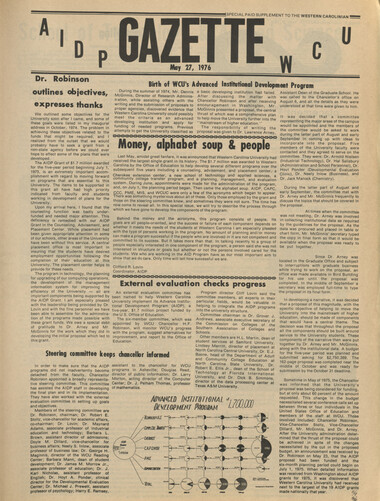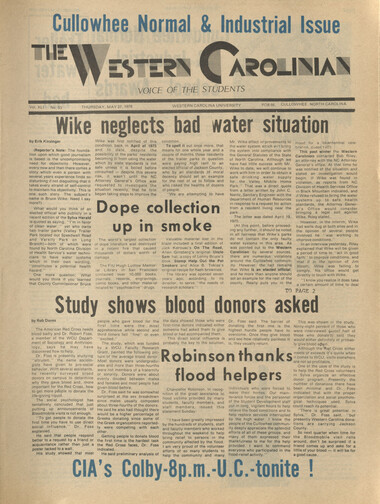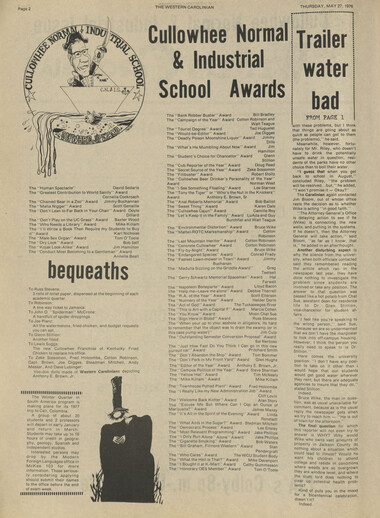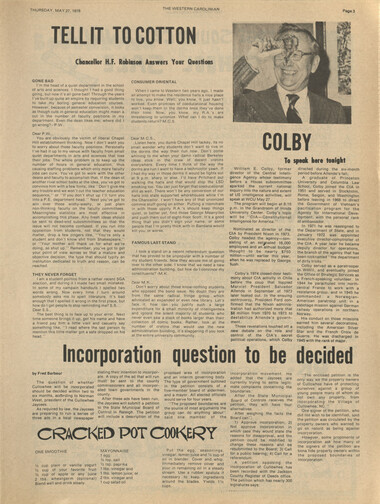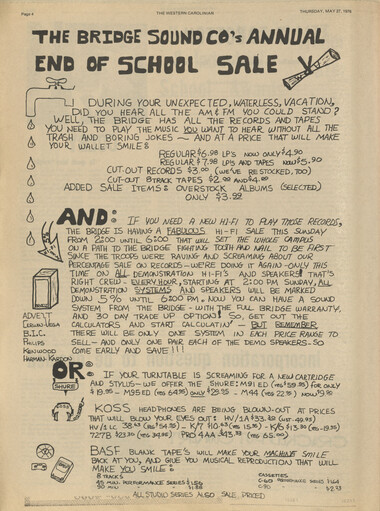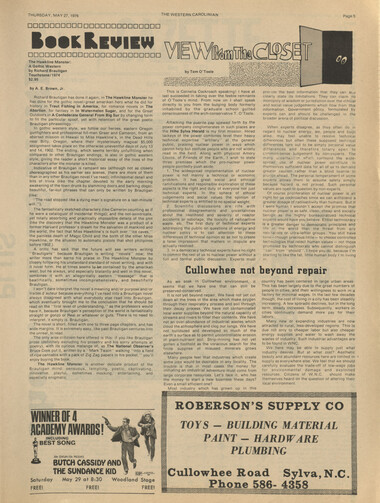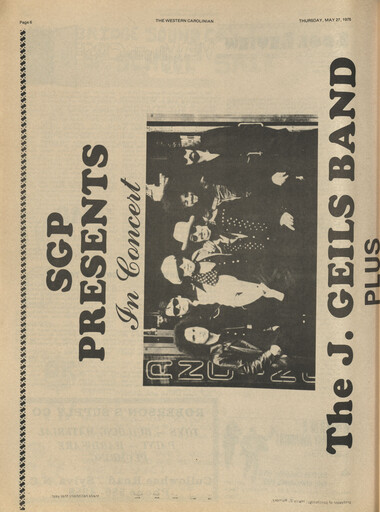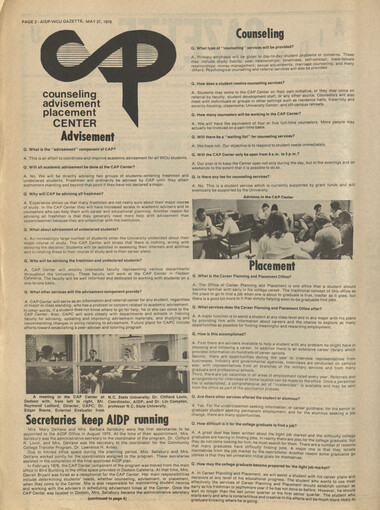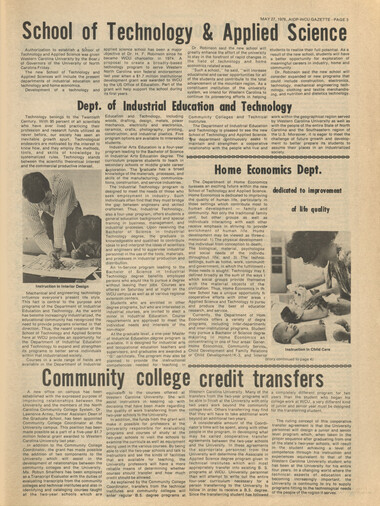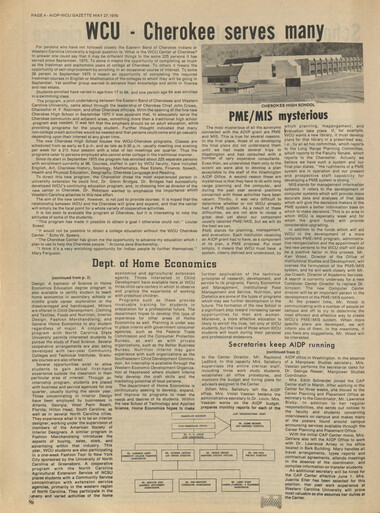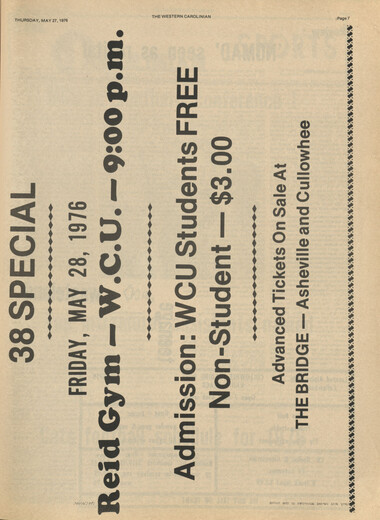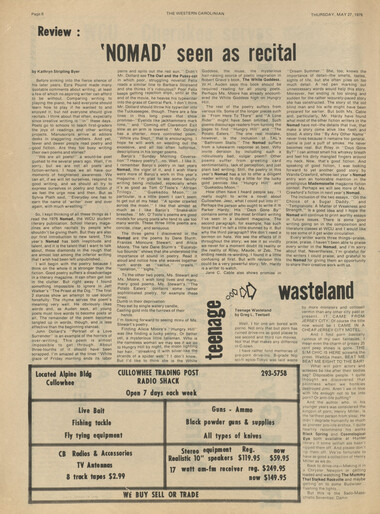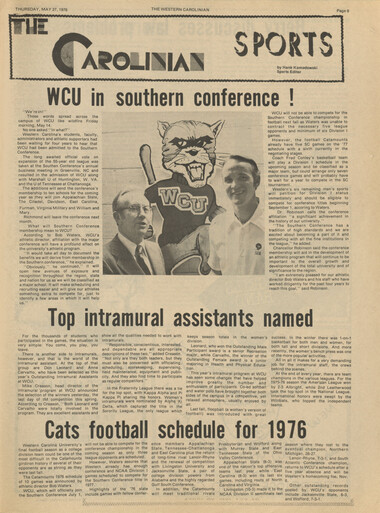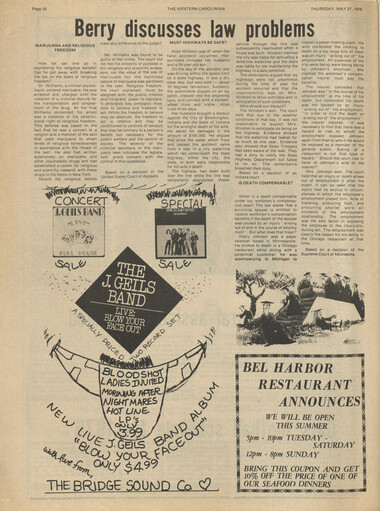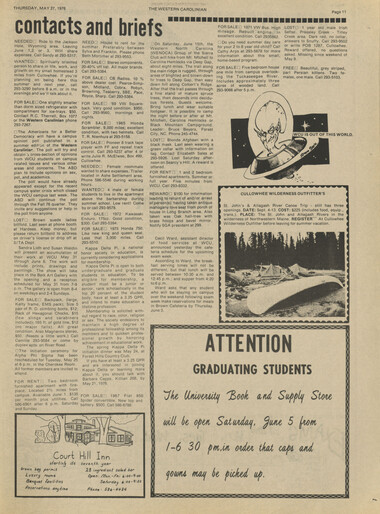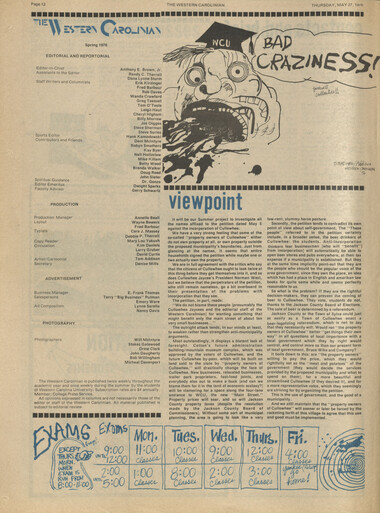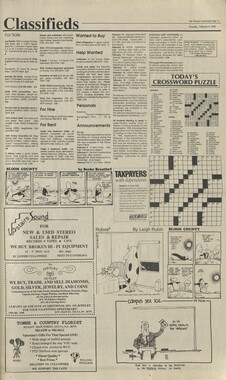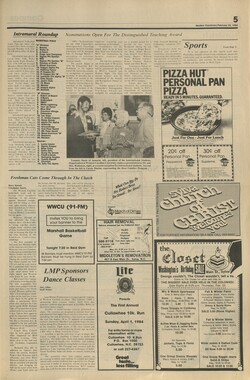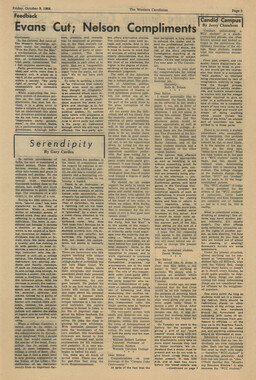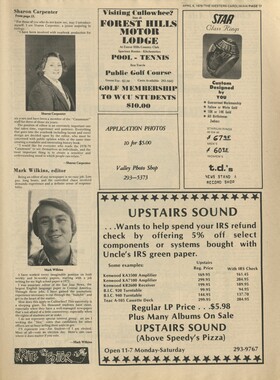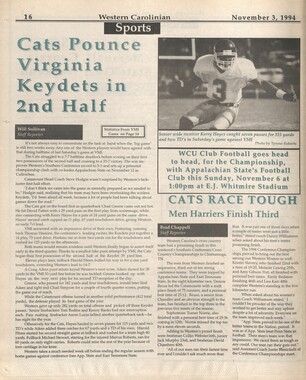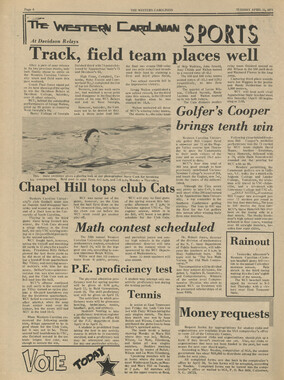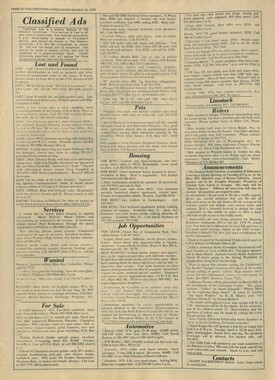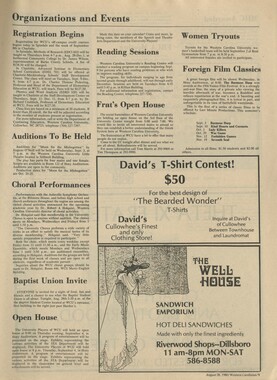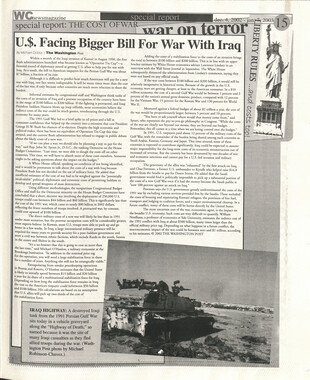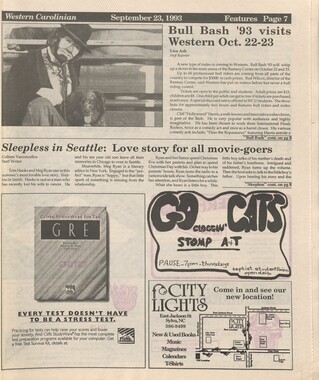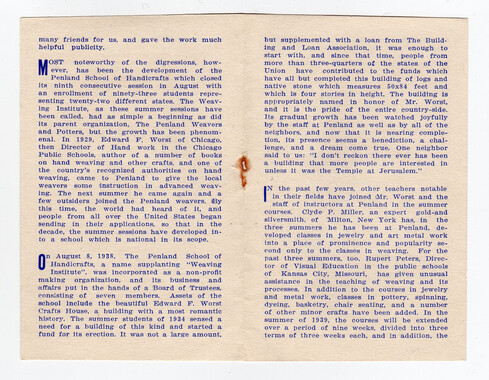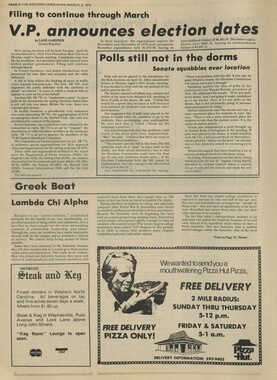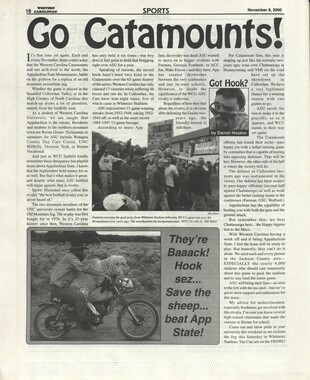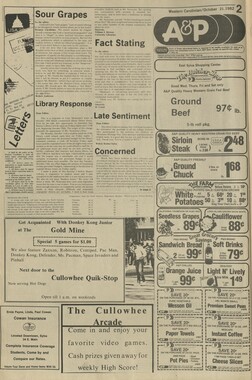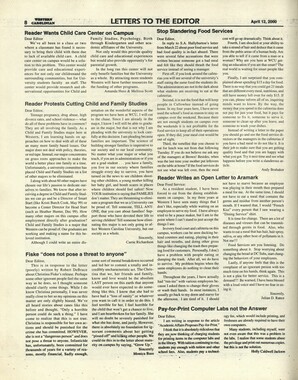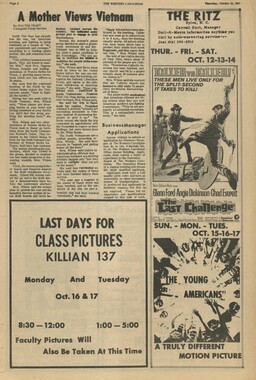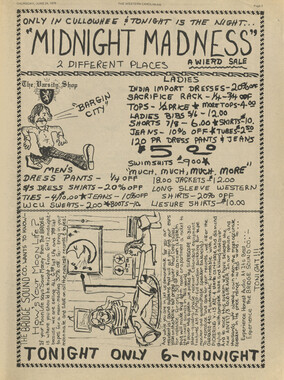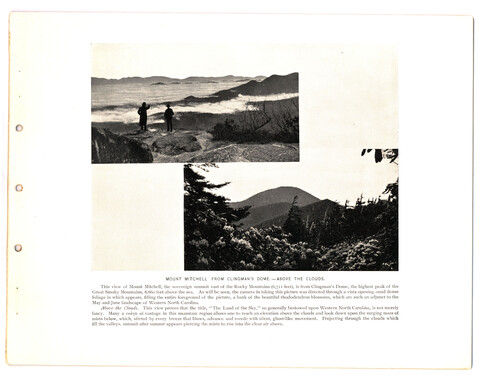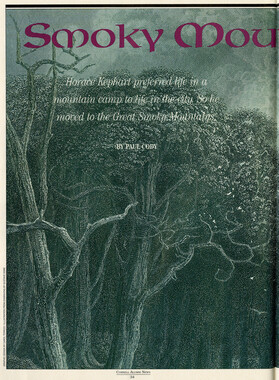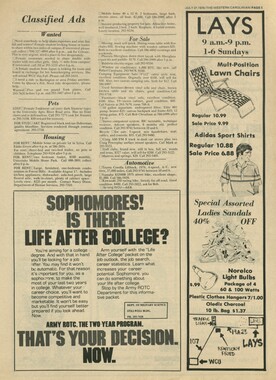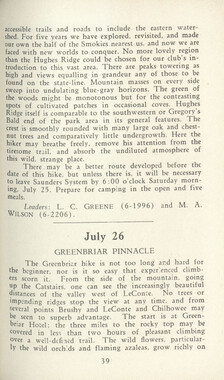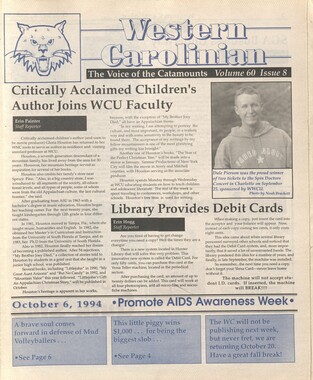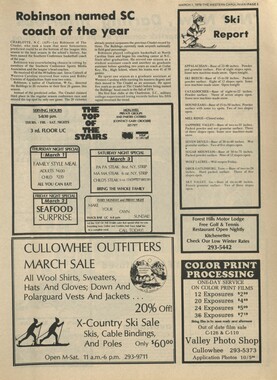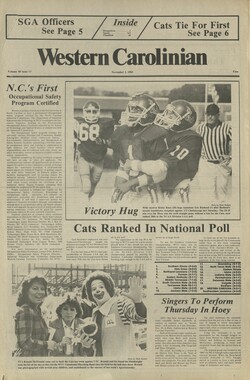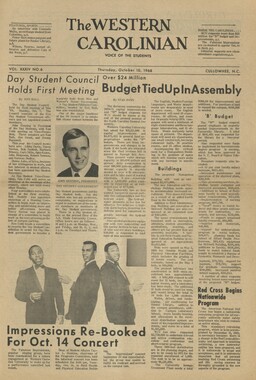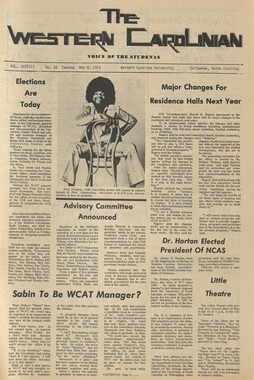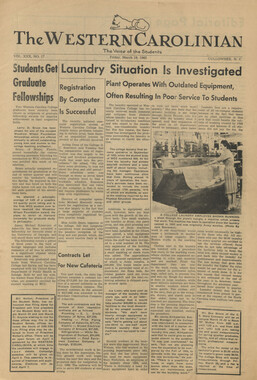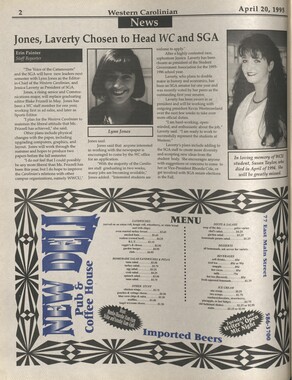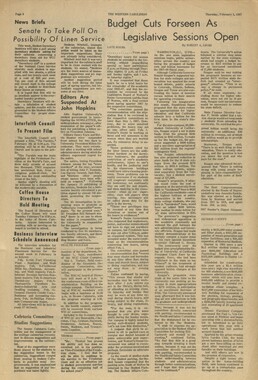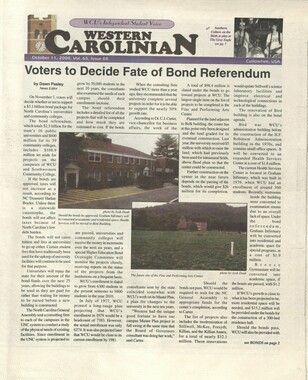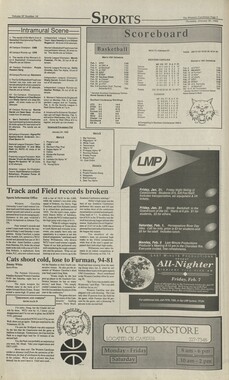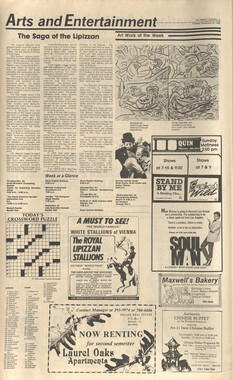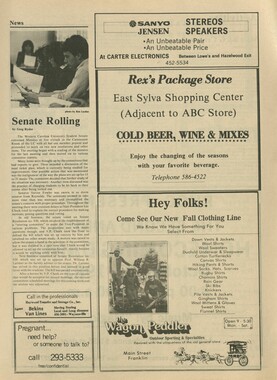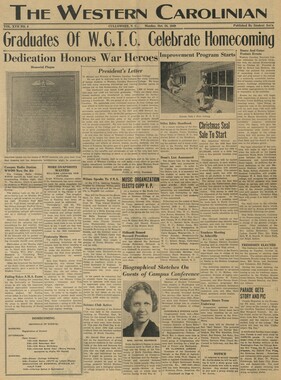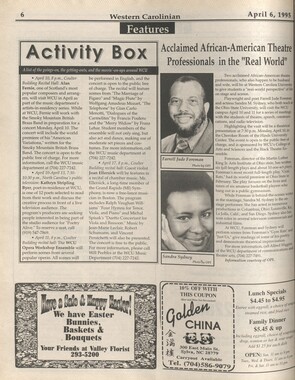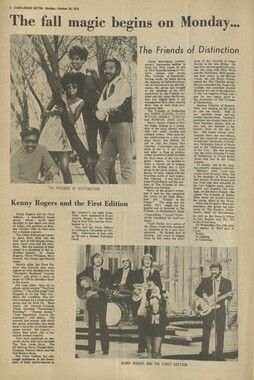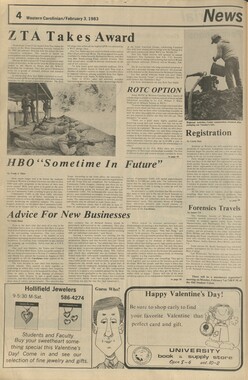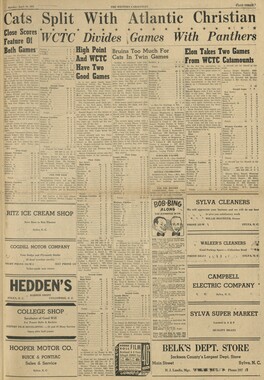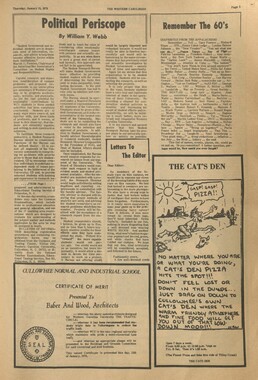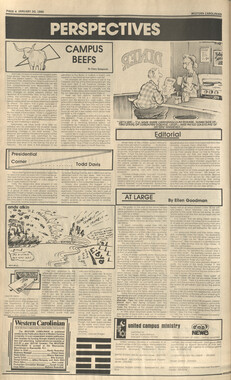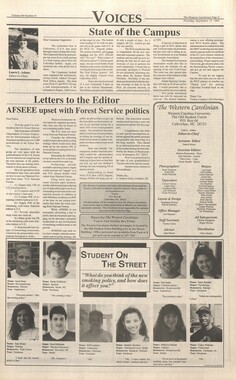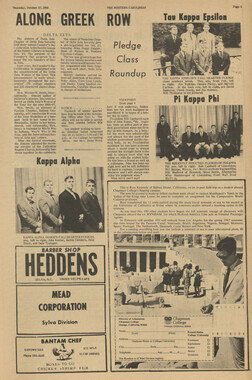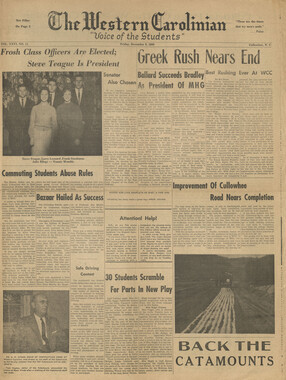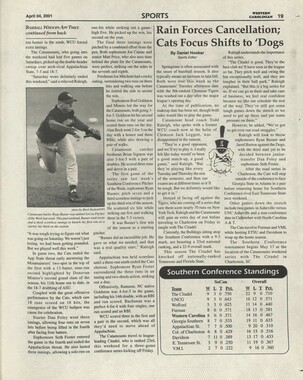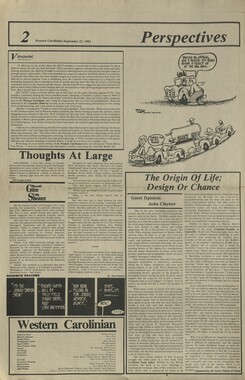Western Carolina University (20)
View all
- Canton Champion Fibre Company (2308)
- Cherokee Traditions (293)
- Civil War in Southern Appalachia (165)
- Craft Revival (1942)
- Great Smoky Mountains - A Park for America (2767)
- Highlights from Western Carolina University (430)
- Horace Kephart (941)
- Journeys Through Jackson (154)
- LGBTQIA+ Archive of Jackson County (26)
- Oral Histories of Western North Carolina (314)
- Picturing Appalachia (6772)
- Stories of Mountain Folk (413)
- Travel Western North Carolina (160)
- Western Carolina University Fine Art Museum Vitreograph Collection (129)
- Western Carolina University Herbarium (92)
- Western Carolina University: Making Memories (708)
- Western Carolina University Publications (2283)
- Western Carolina University Restricted Electronic Theses and Dissertations (146)
- Western North Carolina Regional Maps (71)
- World War II in Southern Appalachia (131)
University of North Carolina Asheville (6)
View all
- Allanstand Cottage Industries (62)
- Appalachian National Park Association (53)
- Bennett, Kelly, 1890-1974 (1388)
- Berry, Walter (76)
- Brasstown Carvers (40)
- Carver, George Washington, 1864?-1943 (26)
- Cathey, Joseph, 1803-1874 (1)
- Champion Fibre Company (233)
- Champion Paper and Fibre Company (297)
- Cherokee Indian Fair Association (16)
- Cherokee Language Program (22)
- Crowe, Amanda (40)
- Edmonston, Thomas Benton, 1842-1907 (7)
- Ensley, A. L. (Abraham Lincoln), 1865-1948 (275)
- Fromer, Irving Rhodes, 1913-1994 (70)
- George Butz (BFS 1907) (46)
- Goodrich, Frances Louisa (120)
- Grant, George Alexander, 1891-1964 (96)
- Heard, Marian Gladys (60)
- Kephart, Calvin, 1883-1969 (15)
- Kephart, Horace, 1862-1931 (313)
- Kephart, Laura, 1862-1954 (39)
- Laney, Gideon Thomas, 1889-1976 (439)
- Masa, George, 1881-1933 (61)
- McElhinney, William Julian, 1896-1953 (44)
- Niggli, Josephina, 1910-1983 (10)
- North Carolina Park Commission (105)
- Osborne, Kezia Stradley (9)
- Owens, Samuel Robert, 1918-1995 (11)
- Penland Weavers and Potters (36)
- Roberts, Vivienne (15)
- Roth, Albert, 1890-1974 (142)
- Schenck, Carl Alwin, 1868-1955 (1)
- Sherrill's Photography Studio (2565)
- Southern Highland Handicraft Guild (127)
- Southern Highlanders, Inc. (71)
- Stalcup, Jesse Bryson (46)
- Stearns, I. K. (213)
- Thompson, James Edward, 1880-1976 (226)
- United States. Indian Arts and Crafts Board (130)
- USFS (683)
- Vance, Zebulon Baird, 1830-1894 (1)
- Weaver, Zebulon, 1872-1948 (58)
- Western Carolina College (230)
- Western Carolina Teachers College (282)
- Western Carolina University (1794)
- Western Carolina University. Mountain Heritage Center (18)
- Whitman, Walt, 1819-1892 (10)
- Wilburn, Hiram Coleman, 1880-1967 (73)
- Williams, Isadora (3)
- Cain, Doreyl Ammons (0)
- Crittenden, Lorraine (0)
- Rhodes, Judy (0)
- Smith, Edward Clark (0)
- Appalachian Region, Southern (2399)
- Asheville (N.C.) (1917)
- Avery County (N.C.) (26)
- Blount County (Tenn.) (161)
- Buncombe County (N.C.) (1671)
- Cherokee County (N.C.) (283)
- Clay County (N.C.) (555)
- Graham County (N.C.) (233)
- Great Smoky Mountains National Park (N.C. and Tenn.) (510)
- Haywood County (N.C.) (3522)
- Henderson County (N.C.) (70)
- Jackson County (N.C.) (4692)
- Knox County (Tenn.) (25)
- Knoxville (Tenn.) (12)
- Lake Santeetlah (N.C.) (10)
- Macon County (N.C.) (420)
- Madison County (N.C.) (211)
- McDowell County (N.C.) (39)
- Mitchell County (N.C.) (132)
- Polk County (N.C.) (35)
- Qualla Boundary (981)
- Rutherford County (N.C.) (76)
- Swain County (N.C.) (2113)
- Transylvania County (N.C.) (247)
- Watauga County (N.C.) (12)
- Waynesville (N.C.) (73)
- Yancey County (N.C.) (72)
- Aerial Photographs (3)
- Aerial Views (60)
- Albums (books) (4)
- Articles (1)
- Artifacts (object Genre) (228)
- Bibliographies (1)
- Biography (general Genre) (2)
- Cards (information Artifacts) (38)
- Clippings (information Artifacts) (191)
- Crafts (art Genres) (622)
- Depictions (visual Works) (21)
- Design Drawings (1)
- Drawings (visual Works) (184)
- Envelopes (73)
- Facsimiles (reproductions) (1)
- Fiction (general Genre) (4)
- Financial Records (12)
- Fliers (printed Matter) (67)
- Glass Plate Negatives (381)
- Guidebooks (2)
- Internegatives (10)
- Interviews (812)
- Land Surveys (102)
- Letters (correspondence) (1013)
- Manuscripts (documents) (619)
- Maps (documents) (177)
- Memorandums (25)
- Minutes (administrative Records) (59)
- Negatives (photographs) (5835)
- Newsletters (1285)
- Newspapers (2)
- Occupation Currency (1)
- Paintings (visual Works) (1)
- Pen And Ink Drawings (1)
- Periodicals (193)
- Personal Narratives (10)
- Photographs (12976)
- Plans (maps) (1)
- Poetry (7)
- Portraits (1960)
- Postcards (329)
- Programs (documents) (151)
- Publications (documents) (2237)
- Questionnaires (65)
- Scrapbooks (282)
- Sheet Music (2)
- Slides (photographs) (402)
- Songs (musical Compositions) (2)
- Sound Recordings (796)
- Specimens (92)
- Speeches (documents) (15)
- Tintypes (photographs) (8)
- Transcripts (322)
- Video Recordings (physical Artifacts) (23)
- Vitreographs (129)
- Text Messages (0)
- A.L. Ensley Collection (275)
- Appalachian Industrial School Records (7)
- Appalachian National Park Association Records (336)
- Axley-Meroney Collection (2)
- Bayard Wootten Photograph Collection (20)
- Bethel Rural Community Organization Collection (7)
- Blumer Collection (5)
- C.W. Slagle Collection (20)
- Canton Area Historical Museum (2110)
- Carlos C. Campbell Collection (282)
- Cataloochee History Project (65)
- Cherokee Studies Collection (4)
- Daisy Dame Photograph Album (5)
- Daniel Boone VI Collection (1)
- Doris Ulmann Photograph Collection (112)
- Elizabeth H. Lasley Collection (1)
- Elizabeth Woolworth Szold Fleharty Collection (4)
- Frank Fry Collection (95)
- George Masa Collection (173)
- Gideon Laney Collection (452)
- Hazel Scarborough Collection (2)
- Hiram C. Wilburn Papers (28)
- Historic Photographs Collection (236)
- Horace Kephart Collection (861)
- Humbard Collection (33)
- Hunter and Weaver Families Collection (1)
- I. D. Blumenthal Collection (4)
- Isadora Williams Collection (4)
- Jesse Bryson Stalcup Collection (47)
- Jim Thompson Collection (224)
- John B. Battle Collection (7)
- John C. Campbell Folk School Records (80)
- John Parris Collection (6)
- Judaculla Rock project (2)
- Kelly Bennett Collection (1407)
- Love Family Papers (11)
- Major Wiley Parris Civil War Letters (3)
- Map Collection (12)
- McFee-Misemer Civil War Letters (34)
- Mountain Heritage Center Collection (4)
- Norburn - Robertson - Thomson Families Collection (44)
- Pauline Hood Collection (7)
- Pre-Guild Collection (2)
- Qualla Arts and Crafts Mutual Collection (12)
- R.A. Romanes Collection (681)
- Rosser H. Taylor Collection (1)
- Samuel Robert Owens Collection (94)
- Sara Madison Collection (144)
- Sherrill Studio Photo Collection (2558)
- Smoky Mountains Hiking Club Collection (616)
- Stories of Mountain Folk - Radio Programs (374)
- The Reporter, Western Carolina University (510)
- Venoy and Elizabeth Reed Collection (16)
- WCU Gender and Sexuality Oral History Project (32)
- WCU Mountain Heritage Center Oral Histories (25)
- WCU Oral History Collection - Mountain People, Mountain Lives (71)
- WCU Students Newspapers Collection (1744)
- Western North Carolina Tomorrow Black Oral History Project (69)
- William Williams Stringfield Collection (2)
- Zebulon Weaver Collection (109)
- African Americans (390)
- Appalachian Trail (35)
- Artisans (521)
- Cherokee art (84)
- Cherokee artists -- North Carolina (10)
- Cherokee language (21)
- Cherokee pottery (101)
- Cherokee women (208)
- Church buildings (167)
- Civilian Conservation Corps (U.S.) (110)
- College student newspapers and periodicals (1830)
- Dams (103)
- Dance (1023)
- Education (222)
- Floods (61)
- Folk music (1015)
- Forced removal, 1813-1903 (2)
- Forest conservation (220)
- Forests and forestry (921)
- Gender nonconformity (4)
- Great Smoky Mountains National Park (N.C. and Tenn.) (181)
- Hunting (38)
- Landscape photography (10)
- Logging (103)
- Maps (84)
- Mines and mineral resources (8)
- North Carolina -- Maps (18)
- Paper industry (38)
- Postcards (255)
- Pottery (135)
- Railroad trains (71)
- Rural electrification -- North Carolina, Western (3)
- School integration -- Southern States (2)
- Segregation -- North Carolina, Western (5)
- Slavery (5)
- Sports (452)
- Storytelling (245)
- Waterfalls -- Great Smoky Mountains (N.C. and Tenn.) (66)
- Weaving -- Appalachian Region, Southern (280)
- Wood-carving -- Appalachian Region, Southern (328)
- World War, 1939-1945 (173)
Western Carolinian Volume 41 Number 53
Item
Item’s are ‘child’ level descriptions to ‘parent’ objects, (e.g. one page of a whole book).
-
-
GAZETTE ^SPECIAL PAID SUPPLEMENT TO THE WESTERN CAROLINIAN ■ u May 27, 1976 w Birth of WCU's Advanced Institutional Development Program Dr. Robinson outlines objectives, expresses thanks We outlined some objectives for the University soon after I came, and some of these goals were listed in my inaugural address in October, 1974. The problem in achieving these objectives related to the funds that might be required, and I realized from the outset that we would probably have to seek a grant from a non-state agency before we could ever hope to effect some of the plans that were Last May amidst great fanfare, it was announced that Western Carolina University had developed. received the largest single grant in its history. The $1.7 million was awarded to Western The AIDP Grant of $1.7 million awarded Carolina by the Office of Education to help develop several different programs over the During the summer of 1974, Mr. Denr McGinnis, Director of Research Administration, while assisting others with the writing and the submission of proposals to proper agencies, discovered evidence that Western Carolina University could possibly meet the criteria as an advanced developing institution and apply for funding of needed programs. Previous attempts to get the University classified as a basic developing institution had failed. After discussing the matter with Chancellor Robinson and after receiving encouragement in Washington, Mr. McGinnis presented a proposal, the central thrust of which was a comprehensive plan to help move the University further into the "mainstream of higher education." The responsibility of writing the proposal was given to Dr. Lawrence Arney, 30000000000 Money, alphabet soup & people subsequent f for the five-year period beginning July 1975, is an extremely important accoi.. plishment with regard to moving forward £ommunit on programs that are essential to this University. The items to be supported in this grant all have had high priority indicated from faculty and students years including a counseling, advisement, and placement center, center, a new school of technology and applied sciences, community college transfer program, and a planning, management, and evaluation system. During June, appointments were made for the administration of the program, and, on July 1, the planning period began. Then came the alphabet soup. AIDP, CAPC, CCC, PME, MIS, and WCUC were only a few of the acronyms which began to appear. There was something mysterious about all of these. Only those employed by the grant and working in development of plans for the ,hose on (he steering committee knew, and sometimes they were not University. now come (0 reveal all. In this special issue, we will try to describe the process through Upon my arrival here, I found that the whjch we have gone to develop the components of the program, counseling function was badly underfunded and needed major attention. This Behind the money and the acronyms, this program consists of people. Its deficiency is remedied with our AIDP goa|S are all people-oriented, and the success or failure of each component depends on Grant in the Counseling, Advisement, and wnether it meets the needs of the students at Western Carolina I am especially pleased Placement Center. While placement had witn ,ne ,ype of persons working in the program. No amount of planning and/or money been given appropriate attention in some can make a pr0gram successful if the people who are involved in it are not competent and of our schools, other areas of the University corr)mitted t0 lts succeSs. But it takes more than that. In talking recently to a group of have been without this service. A central peop)e especially interested in one component of the program, a person said she was not interested in structure or goals but whether or not the persons involved cared for the the AID Program have as our most important aim to ill tell how successful we are. placement office is most importar insuring that the students have desired s't'udents~We who are working show that we do care. Only time l external evaluation committee has employment opportunities following completion of their education at tt University. The placement center helps to provide for these needs. The program in technology, the planning for upgrading of our computing operations, the development of the management information system for improving the efficiency of the University — all are important components being supported by Deen named to help Western Carolina the AIDP Grant. I am especially pleased university implement its Advance Institu- with the leadership being provided by Dr. tional Development Program (AIDP), a Lovin and with the fine personnel we have fjve.year, $1.7 million project funded by been able to assemble for the adminstra- the U.S. Office of Education, tion of the programs made possible with The six-member committee, which was these grant funds. We owe a special debt appointed by WCU Chancellor H.F. of gratitude to Dr. Arney and Mr. Robinson, will monitor WCU's progress McGinnis for the work which they did in wjth the program, suggest alternatives for developing the initial proposal which led to improvement, and report to the Office of this grant. Education. External evaluation checks progress Program director Cliff Lovin said the committee members, all experts in their particular fields, would be valuable in helping to integrate the AIDP programs into the university structure. Committee chairman is Dr. Grover J. Andrews, associate executive secretary of the Commission on Colleges of the Southern Association of Colleges and Schools. Other members are H.L. Martin, dean of student services at Samford University, Lindsey Merritt, director of placement at North Carolina Central University, Dr. E.J. Boone, head of the Department of Adult and Community College Education at >>..~w^i~ *„r iA/r-i 1 North Carolina State University, Dr. In order to make sure that the AIDP assistant to the chancellor for WCU Rober( £ E||js ^ Qf x programs did not inadvertently become programs in Asheville, Douglas Reed, Techn0|0gy at Rorida international detached from the faculty, Chancellor director of public information; Dr. Larry Unlversi,ygyand Dr. Dick B Si°m°™ Robinson appointed a broadly represents Morton. <"'^Rector of the Computer director Qf dgta . centef live steering committee. This committee Center; Dr. J. Pelham Thomas, professor Texas A&M University has assisted the AIDP staff in developing of mathematics, the final plan and in its implementation. MWCED IH5WUTI0HAL Jl 7/Y)mn Steering committee keeps chancellor informed They have also worked evaluation committee in setting up goats and objectives. Members of the steering committee are Dr. Robinson, chairman; Dr. Robert E. Stoltz, vice-chancellor for academic affairs, co-chairman; Dr. Lovin; Dr. Maynard Adams, associate professor of industrial education and technology; Barbara L. Brown, assistant director of admissions; Doyle M. Dillard, vice-chancellor for business affairs; Neely S. Inlow, associate professor of business law; Dr. George H. Maginnis, director of the WCU Reading Center; Barbara Mann, dean of student development; Dr. James M. Morrow Jr., associate professor of education; Dr. J. Karl Nicholas, assistant professor of English; Dr. Hoyt A. Ponder, clinical director for the Developmental Evaluation Center; Dr. Michael J. Prewett, assistant professor of psychology; Harry E. Ramsey, DtmOPMLNT PAOGBAM TuT-l'l" It I I ■e—~G—=0 -fj) •- 1 ^G-=r>-e—•- 9~Q-(3-$-$ - Assistant Dean of the Graduate School. He was called to the Chancellor's office on August 6, and all the details as they were understood at that time were given to him. It was decided that a committee representing the major areas of the campus would be appointed and the members of the committee would be asked to work during the latter part of August and early September in coming up with ideas to incorporate into the proposal. Five members of the University faculty were contacted and they agreed to serve on the committee. They were: Dr. Arnold Nielsen (Industrial Technology), Dr. Hal Salisbury (Administration and School Personnel), Dr. Hovt Ponder (Developmental Evaluation Clinic), Dr. Neely Inlow (Business), and Dr. Jack Manock (Chemistry). During the latter part of August and early September, the committee met with Dr. Arney and Mr. McGinnis frequently to discuss the topics that should be covered in the proposal. At times when the committee was not meeting, Dr. Arney was involved in collecting institutional data as required by the guidelines for the proposal. As the data was procured and placed in table or chart form, Mr. McGinnis' secretary typed the copy in final form so that it would be available when the proposal was ready to be put together. Since Dr. Arney was located in the Graduate Office and subject to interruptions with graduate business while trying to work on the proposal, an office was made available in Bird Building for his use until the proposal was completed. In the middle of September a secretary was employed full-time to type the proposal in its final form. In developing a narrative, it was decided that a proposal of this magnitude, with the specific objective of helping to move the University into the mainstream of higher education, should be made of components that would have a central theme. The decision was that throughout the proposal all the components should be built around service to the University students. These components of the narrative then were put together by Dr. Arney and Mr. McGinnis, along with the institutional data. A budget for the five-year period was planned and submitted asking for $2,750,289. The 162-page proposal was completed near the middle of October and was ready for submission by the October 31 deadline. Sometime in May of 1975, the Chancellor was informed that the University's proposal was being considered for funding, but at only about 60 percent of the amount requested. This change in the budget necessitated several conference calls set up between three or four individuals in the United States Office of Education and members of the staff at WCU. Those involved included: Chancellor Robinson, Vice-Chancellor Stoltz, Vice-Chancellor Dillard, Mr. McGinnis, and Dr. Arney. After the University adminstration determined that the thrust of the proposal could be achieved in spite of the changes necessitated by the cut in the proposed budget, an announcement was received by Dr. Robinson on May 23, that the AIDP proposal had been funded and the six-month planning period could begin on July 1, 1975. When detailed information was received from Washington about AIDP grants for 1975, it was discovered that Western Carolina University had received next to the largest of the 19 AIDP grants made nationally that year. 4
Object
Object’s are ‘parent’ level descriptions to ‘children’ items, (e.g. a book with pages).
-
The Western Carolinian is Western Carolina University's student-run newspaper. The paper was published as the Cullowhee Yodel from 1924 to 1931 before changing its name to The Western Carolinian in 1933.
-
